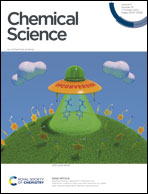Thermodynamic rules for zeolite formation from machine learning based global optimization†
Abstract
While the [TO4] tetrahedron packing rule leads to millions of likely zeolite structures, there are currently only 252 types of zeolite frameworks reported after decades of synthetic efforts. The subtle synthetic conditions, e.g. the structure-directing agents, pH and the feed ratio, were often blamed for the limited zeolite types due to the complex kinetics. Here by developing machine learning global optimization techniques, we are now able to establish the global potential energy surface of a typical zeolite system, SixAlyPzO2Hy−z with 12 T atoms (T: Si, Al and P) that is the general formula shared by CHA, ATS, ATO and ATV zeolite frameworks. After analyzing more than 106 minima data, we identify thermodynamic rules on energetics and local bonding patterns for stable zeolites. These rules provide general guidelines to classify zeolite types and correlate them with synthesis conditions. The machine learning based atomistic simulation thus paves a new way towards rational design and synthesis of stable zeolite frameworks with desirable compositions.



 Please wait while we load your content...
Please wait while we load your content...